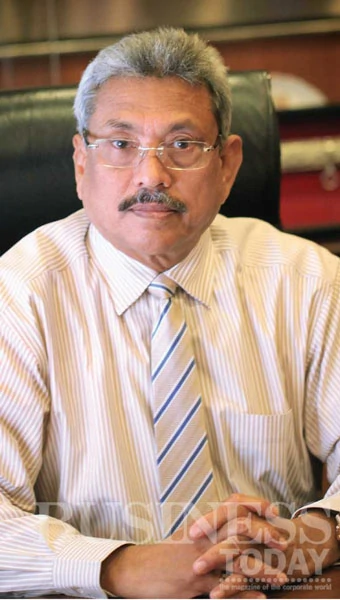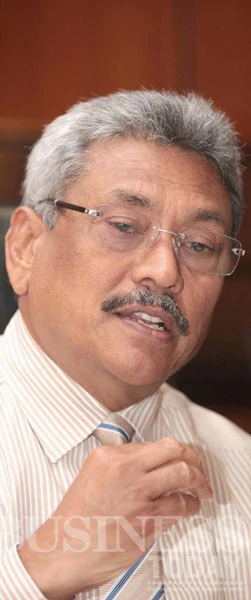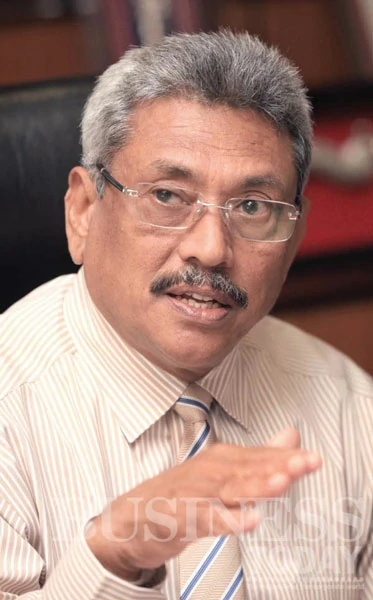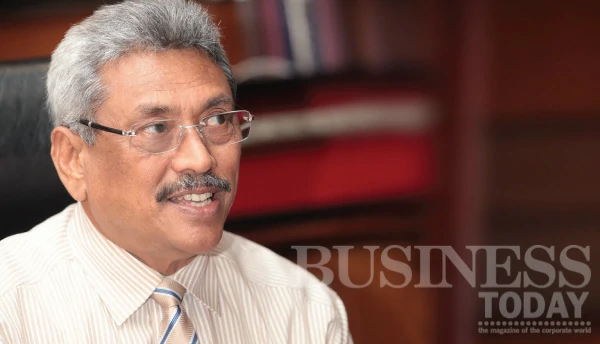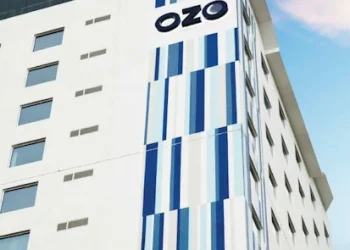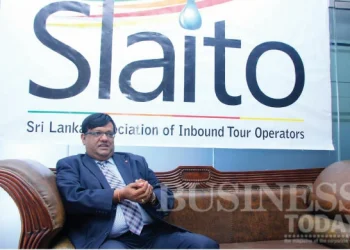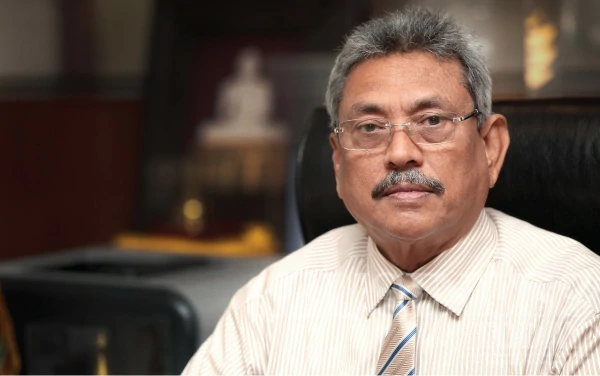
Sri Lanka commemorates five years of achieving peace and freedom after the elimination of the LTTE-the world’s most ruthless terrorist organisation—in May 2009. None thought this was possible, but the Sri Lanka Army, Navy and Air Force together with the Police, Civil Defence Force and Military Intelligence were able to achieve this task under the leadership of President Mahinda Rajapaksa and direction of Gotabaya Rajapaksa, Secretary of Defence. Many would think that the challenges of conflict end when the fighting stops. But, that is not true, different types of challenges remain, some within the country and others overseas.
Sri Lanka is in a unique position, where the people within the country enjoy peace and freedom but there are those overseas who are trying to cause instability within the country. Their motivation only they know, but the people of this country, especially the North want to live their lives for the sake of their children. Gotabaya Rajapaksa, Secretary of Defence as well as Urban Development, stresses the need for the international community and other sections to understand the challenges that the country faces in the post conflict environment as well as how each has been addressed successfully.
They should not imagine smoke when there is no fire…
Gotabaya Rajapaksa, Secretary to the Ministry of Defence and Urban Development,
is a man of his word, punctual and disciplined he has transformed the entire defence establishment and… in an almost opposite sphere he has done the impossible of making Colombo, one of the cleanest and beautiful cities in the world.
By Udeshi Amarasinghe Photography Menaka Aravinda and Mahesh Bandara
We are extremely proud to be interviewing you on the day we commemorate five years of gaining freedom for this country. Can you tell us about the progress made since then?
The people of this country were very much aware of the situation and the challenges that were prevalent in Sri Lanka prior to 2005. At the time the President was first elected in 2005 and I was appointed as the Defence Secretary, the main aim was to defeat terrorism, which we were able to do within a period of four years. The Sri Lankan Armed Forces were able to defeat the massive military machinery of the LTTE that was developed for 30 years. This was a huge victory for the people of Sri Lanka. However, with the defeat of the LTTE,
the government and the military had to face many other post conflict challenges.
During the Humanitarian Operations we rescued nearly 300,000 people who had been forced to live under the LTTE. One of the main challenges was to resettle the displaced and we wanted to resettle them back in their original places. Then, the second challenge was the rehabilitation and reintegration of LTTE cadres that surrendered to the military and also the nearly 5,000 detainees that were at various camps who had been taken into custody over a period of time by the Police and Military as suspects in relation to attacks including suicide bombings.
The President’s Intention Was To Resettle The IDPs As Soon As Possible. However, The Biggest Problem Encountered Was The Prevalence Of Excessive Numbers Of Landmines That The LTTE Had Planted To Delay The Advance Of The Military…
Initially the government had to house IDPs in welfare camps. But we took the decision to resettle them in their own land as soon as possible. Many people including the international community, NGOs, certain Tamil political parties and the diaspora did not expect this as they suspected that the government will not resettle them back in their own land. They thought that we would resettle them somewhere else and that Sinhala and the other communities will be settled in the areas to change the demography of the North. People may have forgotten this now but that was the thinking at that time. The government never thought in this way. There are sections in
Sri Lanka and abroad who do not understand the sincerity of the government. The President’s intention was to resettle the IDPs as soon as possible. However, the biggest problem encountered was the prevalence of excessive numbers of landmines that the LTTE had planted to delay the advance of the military-this included anti personal mines, anti tank mines and different types of explosives. In order to resettle the people in their own land we had to first demine an extensive area of land in the North.
We assigned this task to a number of local and international NGOs. But we found that they did not have the capacity to complete this task within a short period of time. One such instance was immediately after the war the President visited Vavuniya and an organisation gave a presentation on how they were going to demine the whole area. At the end of the presentation the President asked them how long they required and they said 12 years. This was unacceptable to the President as he did not
wish to see these people in welfare camps for
12 years. He gave the order for us to use the services of the Army Engineering Corp to engage in the demining process together with
a few selected NGOs. We are extremely proud that within a period of three years we have completed 70 percent of the demining process.
As the demining progressed we gradually started to resettle the people in the cleared areas. The Presidential Task Force and also the Ministry of Resettlement were the main bodies that were in charge of resettling the IDPs.
We have been able to resettle the displaced within a period of three years and I can say that 98 percent of the people have been resettled. Due to unavoidable reasons, we have not been able to resettle people in areas, which are strategically important. That is about two percent of the total and we have given them alternate land.
As of today, we have resettled all those who were displaced during the Humanitarian Operations but there is a smaller number in the Jaffna peninsular who were displaced since 20 to 25 years ago. They were displaced due to the expansion of the Palaly camp. We are planning to resettle these people as well. We must not mix these people with those who were displaced due to the Humanitarian Operations. That is another area where misinformation is given by the TNA and certain sections of the international community. They are trying to show that these people were also displaced in 2009. They were displaced 20-25 years ago but now we have to find land not only for them but also for the second and third generations of these families. This is the difficulty we are facing in resettling these numbers. However, overall if we look at the resettlement process we have been successful in returning the displaced to their original locations.
What about the surrendees and detainees?
The President was very clear that we should not put them in jail. His thinking was that we must rehabilitate and reintegrate them into the society without putting them behind bars.
We never prosecuted or took legal action against them as our aim was to rehabilitate them. This task was undertaken by the Ministry of Rehabilitation, which was especially created by the President for this purpose. The Military too contributed to this process. While rehabilitating them we have also focused on giving them skills as most of them were forcefully or voluntarily recruited by the LTTE at a very young age. Throughout their lives they had been fighting with weapons, and they did not acquire any skills. We have trained them as carpenters, plumbers, electricians and heavy equipment drivers among others so that they can find employment. As of today we have rehabilitated all the surrendees and detainees and reintegrated them into the society.
Development of the Northern Province has been an important area. What has been done so far?
The conflict affected areas were neglected for a very long time, where development work could not take place due to the insecurity in the region. As soon as the conflict ended the government took action to develop the area starting with the development of the road network and railway network. We started
laying two new railway lines, one from Vavuniya to KKS via Jaffna and the other from Medawachchiya to Mannar. Already about 80 percent of the KKS line has been completed up to Palai and on the other side to Madhu.
At The Same Time The Government Requested The Private Sector To Invest In The North And A Number Of Private Organisations Have Already Established Many Factories, Especially High-End Garment Factories To Address The Unemployment Of The Area.
Electrification was another major area as the North was not linked to the national grid. Approximately 90 percent of the areas have now been given electricity. Reconstruction and rehabilitation of irrigation networks, tanks and canals as well as agricultural land were also a key focus. The government established many projects for the provision of clean drinking water to the people in these areas. The Education system is now fully functional and children are able to sit for their exams without any problems. We all know that the LTTE had child soldiers and a separate brigade for them, these children are now going to school.
At the same time the government requested the private sector to invest in the North and a number of private organisations have already established many factories, especially high-end garment factories to address the unemployment of the area. However, we must understand that the private sector cannot venture immediately as there is a limited number of skilled people. Initially they will have to invest on training the people. Today, the people are free that is the most important thing.
Disarmament of groups has been key for the progress.
While the war with the LTTE was going on there were certain other groups such as PLOTE, EPRLF, EPDP and many more. Prabakaran eliminated the leaders of most of these groups and some of them-PLOTE, Karuna group, EPDP-joined hands with the government forces and assisted in many ways. These groups had been given weapons by successive governments for their own protection. When the government defeated the LTTE we had many issues especially from the international community, NGOs, diaspora and others taking issue that while these group carried weapons, stability and safety of the area could not be ensured. Thus the government took the bold decision to disarm these groups even though they were working with the government. Only the Military and the Police carry weapons today.
What about the establishment of Police stations and the responsibilities of the Police in the North?
During the 30-year long conflict there were no Police stations in the North. We have established Police stations and given the responsibility to the Police as the primary organisation to maintain law and order in this area. Once the military operations ended the Army was gradually withdrawn to the camps as there was no longer a requirement for offensive operations. We started recruiting people from the area into the Police. We also initiated a programme to teach Tamil to all the Police officers from other areas so that they can communicate with the people.
What is the role of the military in the North today?
The responsibilities of the Military gradually changed to civil military activities. That is to assist the people to rebuild their lives because for 30 years they were in this conflict zone.
The military is assisting in the building of houses, infrastructure, medical camps and schools. In numerous ways they are helping the people and winning the hearts and the minds of these people. Over the years the civilians had a different opinion of the military as the LTTE, TNA and various others created a wrong image of them. If you speak to the people today they will tell you how much the military has helped them. No other organisation has helped them as much as the military.
There is freedom in the North now.
The government has repealed the Emergency Regulations. We have relaxed many restrictions in these areas. People can travel anywhere they want just as in the rest of the country.
The fisheries industry is very important to the North and East where many people engaged in this sector. From Mannar in the western coast to Kokilai in the east, the entire belt is occupied by fishermen. Due to the conflict the entire fisheries industry collapsed. There were many restrictions due to the LTTE and fighting in those areas. There were restrictions on the size of the boat, on outboard motors and the distance and the times that the fishermen could venture out to sea. But now the government has taken major steps to assist them by giving free boats, access to loans, provision of various utilities to improve the fisheries industry and also the establishment of ice plants amongst others.
For The First Time Ever, President Mahinda Rajapaksa Held The Northern Provincial Council Elections. People Were Allowed To Elect Their Own Representatives. After The Elections The TNA Formed A Provincial Government And Elected Their
Chief Minister And Cabinet.
We have seen elections being held in the North after 30 years and the Northern Provincial Council was elected where the
TNA was able to secure victory with a Chief Minister from its party. What are your thoughts on this?
The most important achievement that the President was able to secure for the people is their democratic right to vote. During the last 30 years, these people were not able to participate in any elections in a free manner and none of the elections, be it a Presidential, Parliamentary or Provincial Councils, they could not be held in these areas. Even if people were able to participate the numbers were at
a minimum prior to 2009. We can see the increase in the participation of the people
in elections after 2009. Immediately after 2009 we had the Presidential elections first, then the Parliamentary elections, Local Government elections and finally the Provincial Council elections. We saw the participation of the people increase from 12 percent, to 45 percent to 70 percent at the Provincial Council elections. That shows that the confidence is building in those areas. Though the provincial council system was introduced in 1987 with the Indo-Lanka pact where the 13th Amendment was brought in,
no elections were held in the North. After 30 years, for the first time ever, President Mahinda Rajapaksa held the Northern Provincial Council elections. People were allowed to elect their own representatives. After the elections the TNA formed a provincial government and elected their Chief Minister and cabinet. The elections were free and fair and the democratic right was given to the people.
With all this work done, the government is still facing criticism from overseas. What are your thoughts on this?
The Sri Lankan government has faced all these challenges very successfully and it must be appreciated by the international community. We can see from what the country has had to face globally that many are unaware of the progress of the country or they do not want to recognise these achievements for a different purpose. We are facing other challenges of a different nature in the international forums. This is purely undertaken by the Tamil pro LTTE diaspora. Earlier the LTTE wanted to establish eelam through military means, even though successive governments held peace talks at times with a third party facilitator such as India and Norway. Those were not successful. The President was able to defeat them militarily, therefore now they are using a different approach to achieve their aim.
Over the years, the LTTE developed very good international networks. These networks were mainly to raise funds, procure weapons and then ship the weapons to Sri Lanka.
Now the requirement of procuring of weapons is not there, as such they are using their networks for lobbying and false propaganda to achieve their means in a different way. The pro LTTE diaspora is using the money which they are still raising from the different businesses and investments they made earlier, to support various political parties and politicians in other countries. They are lobbying them to put pressure through the United Nations Human Rights Council on Sri Lanka. This is the biggest challenge that we are facing today.
This Was To Deter The LTTE Or Other Extreme Elements From Re-Grouping And Reorganising Themselves, Where They Would Be An Immediate Counter Reaction. We Will Not Give Any Opportunity To These People To Regroup Or Cause Any Disruptions.
At the same time there are certain elements of the diaspora, especially LTTE cadres that have escaped during and after the war to Europe and various places and are trying to regroup and reorganise the military side of the LTTE. There have been several instances where this has happened but our military organisations are very well-equipped and organised to counter these attempts. We understood that this could happen and even though the war ended we remained vigilant and never let down our defences. Immediately after the defeat of the LTTE, we reorganised and repositioned our military and changed our modus operandi to face this threat. The war was going on for such a long time, the LTTE was very well prepared militarily. They had a very good intelligent service and we understood that there could be LTTE leaders who had not surrendered or whom we had not identified living in the society – those who had gone abroad or underground. Furthermore, even though we have rehabilitated and released ex-cadres we cannot say that they are 100 percent de-radicalised. We knew this threat will come one day. From the very first day we prepared ourselves, we strengthened our intelligence organisations. That is one of the reasons that we did not agree to withdraw the military from the North. We will not engage in day to day life but we will position them strategically as certain types of defensive operations would be required. This was to deter the LTTE or other extreme elements from re-grouping and reorganising themselves, where they would be an immediate counter reaction. We will not give any opportunity to these people to regroup or cause any disruptions.
Unfortunately we do not get the support from certain sections of the international community due to various reasons. We have to face that challenge especially in the international forums. Though we have revealed to them the details of the locations of these LTTE cadres, they are living freely because of the attitude of these countries, especially in Canada and western-european countries. These terrorists who engaged in terrorism in Sri Lanka and killed so many civilians are freely living in these countries and now pushing for action against the sovereignty of our nation. That is very unfortunate.
As the President mentioned in his speech
at the Victory Parade, we will face these challenges boldly and in the correct way and
we will succeed.
You are also the Secretary for Urban Development and we see massive changes around the city of Colombo. Can you tell us about the challenges you faced in this vastly different area and also the achievements so far?
I first focused on Colombo because it is our capital and is also our commercial and administrative hub. Colombo is the first point of contact to any visitor who comes to this country whether it is a head of state, foreign delegation, tourist, investor or businessman. As such Colombo is a very important city. Unfortunately during the past, especially due to the conflict the city was neglected and as such there were many issues in the city. I studied these problems and thought of ways to bring the glory of the olden days back to Colombo. I wanted to transform Colombo into a clean, people-friendly and environmentally-friendly city. Keeping that in mind there were many issues that we had to address immediately.
Garbage was a main problem in the city. This is the responsibility of the Municipal Council and Local Government. I set to work with the Colombo Municipality and the local bodies and first studied their systems. Many short comings were detected, which we addressed immediately.
The main reason for failing to clean the city
was that there was no proper control or
supervision. The task of cleaning the city had been given to the private sector but unfortunately these companies were not doing the work
to the satisfaction of the people. There was a time where the roads were not cleaned properly, garbage was dumped everywhere and there were posters on all the walls and electricity polls. I put a stop to all of that and asked the private sector organisations to do their job properly.
In order to supervise and guide these organisations I established an environmental division in the Police, where the responsibility was given to them to supervise and get the work done by the systems that were already in place through the Municipal Council. That was my main task to first clean the city of Colombo.
However, the disposal of garbage is still a huge problem all over our country. The reason for this is that we have not had a proper system for garbage disposal for the past few years.
This is very unfortunate. Garbage was dumped all over the country especially in low lying areas creating a huge problem to those areas where water and environmental pollution has
occurred. We have taken steps to solve this problem. The Colombo Municipality collects nearly 1,000 tonnes of garbage per day where it is dumped at various locations. I received assistance from the World Bank technical team to study this issue and we are planning a long term project to solve this problem. It will take about two years as we have to create a large sanitary dumping area for the proper disposal of garbage, I am sure once this is completed we will be able address the issue of garbage disposal successfully.
What about flood control?
Flooding was a big issue in Colombo and its suburbs, this again was because the canals
had not been maintained properly and due to unauthorised filling of low lying catchment areas. Colombo has a large low lying area where the rain water collected and then gradually went out to sea. Due to unauthorised filling
and construction of buildings in these catchment areas the collected water did not have a place to go. At the same time there was another issue-the unauthorised houses along the low lying areas, especially along the canals which would get flooded during heavy rain. Their sewage was connected to the canals thereby polluting them. I immediately started working with the Sri Lanka Land Reclamation and Development Board and the Navy, and we started to clean and develop the canals by dredging and building of banks. For that too
I received loan assistance from the World Bank.
I am in the process of developing these canals and at the same time, I had to create reservoirs in lower catchment areas especially Kotte and the areas surrounding the Parliament, where the rain water could be controlled immediately and gradually release to the streams so that it could flow to the sea without flooding the houses and the surrounding areas.
To prevent the flooding of Nugegoda, Delkanda, Pepiliyana, Piliyandala and Bellanvila areas we have started work on Werassa Ganga, where the rain water from these areas will flow to Bolgoda Lake and to the sea. This will prevent the flooding of Colombo and suburbs.
This Is A Very Large Investment But It Is Worthwhile Because You Are Not Only Giving Houses To These People You Are Also Changing Their Whole Environment And Lifestyle. We Are Changing Their Mentality And Enabling A Good Environment For The Children To Live In.
What about the issue of unauthorised building and low income housing? This has received much attention during the past few days.
I have started a project to provide better housing facilities and a better environment for low income and unauthorised shanty dwellers. We are building housing units in high rise buildings to be given to these families. This is a very challenging task because we need 60,000 housing units in Colombo. Successive governments have tried to address this issue for a very long time. You cannot solve this problem unless you build a large number of houses at once. We are currently building 15,000 housing units and work on another 10,000 houses will start this year. This is a very large investment but it is worthwhile because you are not only giving houses to these people you are also changing their whole environment and lifestyle. We are changing their mentality and enabling a good environment for the children to live in.
I have started two pilot projects in Slave Island with two private companies, one is with TATA and another private company. Here we do not use any government money. The model is such that the private company builds the housing units for the people living in those areas and to compensate for their expenses they will be given five acres to develop as commercial and mix developments. The houses in this area cannot be called shanties but they are in a very poor state and the area of each house is different. Many of them have only one perch, some others two or three perches and a very few numbers had 20 perches. However, the majority of them were living in a very bad state. The houses that they will be receiving are very different and each house will have a floor plan according to the extent of their original houses. This project
was delayed due to the involvement of certain political parties as they did not understand the concept. Even the media has not understood it. This is a genuine project where it is a win-win situation for everyone, especially for the people. The families in the area will be getting better housing and a better living environment.
The government is also benefitting because we are not spending. We are only mediating between the people and the private company. The company too is gaining since they are given a section of the land that they can develop and cover their expenses. I do not know why the people were protesting and the media was spreading false reports. If we do not develop these areas these people would never be able to get proper accommodation as they are not in a financial position to do so.
Once this project is completed, the entire landscape of Colombo will transform to become a beautiful city.
You always speak about a people-friendly city. Can you elaborate on this?
Even if you do not live in the city but go there for work or other matters, the city has to be attractive as that will change the mindset of the people. It will change the thinking of the people when you have a clean and beautiful city.
The first thing that I did was improve the pavements. More than 80 percent of the people who come to Colombo use the pavements.
With this World Bank project I started developing the roads and the pavements as well as clearing pavement hawkers as pavements are there to walk. Though this is a responsibility of the Municipal Council, we are utilising funds from the World Bank for the construction of pavements.
The other aspect is the improvement of parks. People must be able to relax and enjoy themselves. I have already improved public places and continue to develop areas for people to exercise-walking strips and cycling areas. People can exercise in the morning or evening after work and children can play.
I have started removing the boundary walls of government buildings. All the government establishments had parapet walls around them, it only gave a false sense of security because if someone enters the premises he has freedom to do anything. Because of these parapet walls garbage got collected and places to breed mosquitos grew. When the walls are removed it is beautiful and the landscape is very appealing. This also helps to keep the environment clean.
Colombo has many colonial heritage buildings with very nice architecture, but these were neglected and on the verge of collapse.
If we take the Colombo Racecourse, the buildings were about to be demolished because no one could go there. We renovated these buildings and the next step was maintenance. Our strategy was to renovate the buildings and then let the spaces out for commercial purposes. At the Colombo Racecourse the pavilion for the rugby grounds and the retail spaces have been let for commercial purposes such as shops and restaurants. The money generated through these have been used to maintain the building.
The renovated Old Dutch Hospital is world famous and we have used the same model for this as well. We are currently renovating the old Auditor General’s building. This was actually
the mental hospital during British colonial times. Later on the Auditor General department moved in and they were there for nearly 75 years until they moved into a new building in Battaramulla recently. We have almost completed the renovation and we will be utilising the building for commercial purposes. That area is very beautiful now.
Colombo Will Have A Unique Identity As A Developed Green City Where It Is People Friendly And We Have Preserved Our Heritage. It Will Be A Blend Of The Old And The New.
Another aspect is the planting of trees. The city has to be green that is why I am planting trees on pavements and wherever we are renovating. A mistake made by many cities in the world is that while they develop they become concrete jungles where it is not habitable for people. Colombo will have a unique identity as a developed green city where it is people-friendly and we have preserved our heritage. It will be a blend of the old and the new, where we have international chains such as Shangri-La and ITC as well in the city. We have developed the area surrounding the Beira Lake as well.
We are also carrying out work to preserve our natural flora and fauna in the city. Beddegana is the only available area in close proximity to the city where people can visit,
and students can study nature. I have to stress that people should not fill land in Colombo. According to the study we have done 90 percent of the low lying catchment areas over the years have been filled and only ten percent is left, which we have to preserve. We have to preserve nature and these habitats if not we will lose everything. If this is not stopped we will have a big issue in controlling floods. In the past people have filled abandoned paddy land and built houses without realising that it will cause a huge environmental problem. We are very strict about this and we are not allowing anyone to fill paddy fields. And if anyone has done any unauthorised filling then we will take action. That is why we are creating more tanks and reservoirs to prevent people from filling those areas. In Battaramulla, Hokandara and Thalawathugoda there are many natural habitats, we have to preserve those. Many people have moved to those areas and they must ensure that they protect the beauty and the environment of these areas.
The erection of massive billboards is another problem because it damages the entire environment. It covers the greenery and beauty of Colombo. They must find different ways of advertising because you cannot stay the same all the time.
At the same time, we are now moving
the military establishment as well as government administrative buildings to
Sri Jayewardenepura, Kotte. This move started in the 1970s but it was not completed but we are now shifting, leaving the lands in Colombo available for commercial purposes. The idea is
to have Colombo as the commercial capital and Sri Jayewardenepura as the administrative capital. We are constructing the Defence Headquarters in Akuregoda and the Ministry
of Defence, Army, Navy and Air Force Headquarters will be located there.
The Army Headquarters has already vacated their premises and Shangri-La and ITC have already started work on their hotels. There will be many other developments such as apartments, commercial properties and hotels.
We have to change the city to cater to the requirements of the tourists, investors and businessmen. We have to create these opportunities so that investments can come in. We have to develop the facilities such as hotels and shopping centres so that tourist will come to the country. First you have to build the infrastructure, you have to build the hotels. Only then can you attract the tourists, not the other way around. If the city is developed and the environment created, then we can attract investors.
It must be a beautiful, clean and safe city.
Certain small-minded individuals do not understand or they do not want to understand, they simply criticize for the sake of criticizing. At the same time we have mega developments also taking place such as the Port City and highways to address the traffic. We have people travelling from the South, Kandy and North and they do not have to pass through the city now as they can use the outer circular road, bypassing the city and the traffic to reach their destination. We can develop only around these infrastructure, therefore you have to have the infrastructure first and development will come automatically.
What about development in other areas?
We need the participation of the private sector too for development. The President has created a safe and secure environment by eliminating terrorism and now the government is developing the infrastructure. Some people question as to why an airport and harbour
are required in Hambantota, but they do not understand the potential of having these infrastructure developments in that area-the busiest shipping line is only 25 nautical miles from Hambantota. Investment will come in when the main infrastructure is in place. Not only foreign investors but local investors as well. The main requirement was to first develop Colombo because it is an important hub. From there can we only proceed to other areas. When people from other areas see Colombo they will automatically follow suit to develop their own cities.
I Would Like To Tell The People Of This Country That They Need To Rise Above The Mentality That Sri Lanka Is A Third World Country Because We Are Not. We Are A Developed Country And Heading To A Different Level.
I have made another loan arrangement to develop the cities of Galle and Kandy. At the same time I am developing small cities around the country as well.
Final thoughts?
I would like to tell the people of this country that they need to rise above the mentality that Sri Lanka is a third world country because we are not. We are a developed country and heading to a different level. Everyone must change their attitude and thinking. We must learn from other countries. Many people from our country have visited developed countries. They do not have to go to the West. Within the Asian region we have Japan, China, Korea, Vietnam, Malaysia, Singapore and Indonesia where they have developed their cities so we can take examples from them. We must achieve this in Colombo and Sri Lanka.
